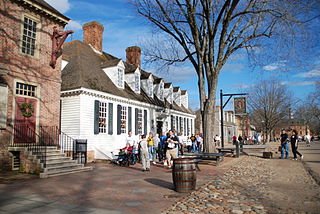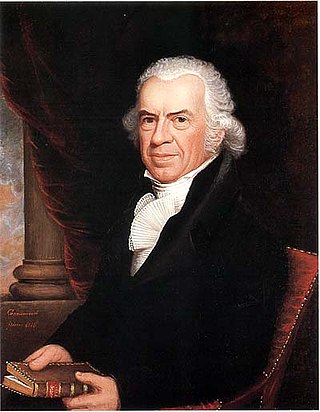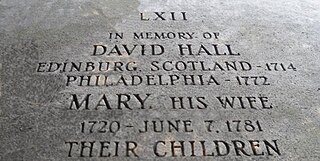
Williamsburg is an independent city in the Commonwealth of Virginia, United States. As of the 2020 census, it had a population of 15,425. Located on the Virginia Peninsula, Williamsburg is in the northern part of the Hampton Roads metropolitan area. It is bordered by James City County on the west and south and York County on the east.

The House of Burgesses was the elected representative element of the Virginia General Assembly, the legislative body of the Colony of Virginia. With the creation of the House of Burgesses in 1642, the General Assembly, which had been established in 1619, became a bicameral institution.

Colonial Williamsburg is a living-history museum and private foundation presenting a part of the historic district in the city of Williamsburg, Virginia. Its 301-acre (122 ha) historic area includes several hundred restored or recreated buildings from the 18th century, when the city was the capital of the Colony of Virginia; 17th-century, 19th-century, and Colonial Revival structures; and more recent reconstructions. The historic area includes three main thoroughfares and their connecting side streets that attempt to suggest the atmosphere and the circumstances of 18th-century Americans. Costumed employees work and dress as people did in the era, sometimes using colonial grammar and diction.
William Pierce Jr. was Founding Father of the United States, military officer during the Revolutionary War, member of the Continental Congress, merchant, and planter and slave owner. As a delegate representing Georgia at the Constitutional Convention of 1787, he left before he could sign the U.S. Constitution.

Isaiah Thomas was an early American printer, newspaper publisher and author. He performed the first public reading of the Declaration of Independence in Worcester, Massachusetts, and reported the first account of the Battles of Lexington and Concord. He was the founder of the American Antiquarian Society.
John Holt (1721—1784) was a colonial American newspaper publisher, printer, postmaster, and mayor of Williamsburg, Virginia, United States. He was involved with publishing the Connecticut Gazette, the New York Gazette, and the New-York Journal newspapers. He worked with Benjamin Franklin, the prominent publisher James Parker, and Founding Father Samuel Adams. He had a store that sold miscellaneous supplies, ink, paper, and books on a variety of subjects including religion, freemasonry, economics, history, archaeology, poetry, and biographies.

Norborne Berkeley, 4th Baron Botetourt, was a British courtier, member of parliament, and royal governor of the colony of Virginia from 1768 until his death in 1770.
The Gazette, founded in 1727 as The Maryland Gazette, is one of the oldest newspapers in America. Its modern-day descendant, The Capital, was acquired by The Baltimore Sun Media Group in 2014. Previously, it was owned by the Capital Gazette Communications group, which published The Capital, Bowie Blade-News, Crofton-West County Gazette, and Capital Style Magazine.
John Fenno was a Federalist Party editor among early American publishers and major figure in the history of American newspapers. His Gazette of the United States played a major role in shaping the beginnings of party politics in the United States in the 1790s.

The Daily Press Inc. is a daily morning newspaper published in Newport News, Virginia, which covers the lower and middle Peninsula of Tidewater Virginia. It was established in 1896 and bought by Tribune Company in 1986. Current owner Tribune Publishing spun off from the company in 2014. In 2016, The Daily Press has a daily average readership of approximately 101,100. It had a Sunday average readership of approximately 169,200. Using a frequently used industry-standard readership of 2.2 readers per copy, the October 2022 readership is estimated to be 38,000. It is the sister newspaper to Norfolk's The Virginian-Pilot, which was its southern market rival until Tribune's purchase of that paper in 2018; the papers have both been based out of the Daily Press building since May 2020.
Andrew Sprowle was a Scottish-born merchant, naval agent, landowner, shipyard owner, slaveholder and slave trader in Portsmouth, Virginia. Today Andrew Sprowle is best remembered for establishing the Gosport Ship Yard, now known as Norfolk Naval Shipyard. Sprowle emigrated from Milton, West Dunbartonshire, Scotland to what is currently the Commonwealth of Virginia in the mid-18th century, where he lived until his death on 29 May 1776.

William Parks was an 18th-century printer and journalist in England and Colonial America. He was the first printer in Maryland authorized as the official printer for the colonial government. He published the first newspaper in the Southern American colonies, the Maryland Gazette. He later became authorized as the official printer for the colonial government of Virginia. Parks was also the publisher and printer of the first official collection of the authentic 1733 set of Virginia's laws, and the first colonial publisher and proprietor of The Virginia Gazette newspaper. During his lifetime Parks established four new newspapers in the colonies. He also worked with Benjamin Franklin on several projects related to printing, most notably, the establishment of a paper mill in Virginia, the first such mill south of Pennsylvania.

Clementina Rind was a Colonial American woman who is known as being the first female newspaper printer and publisher in Virginia. Living and working in Williamsburg, Virginia, she took the printing press established by her husband, William Rind, after his death in 1773. Clementina continued to print The Virginia Gazette and also published Thomas Jefferson's tract A Summary View of the Rights of British America.
Colonel John Chiswell, was a planter, land speculator, early industrialist and member of the Colonial House of Burgesses who in his final years caused a scandal which led to his well-publicized death, possibly a suicide on the eve of his trial for killing a merchant in western Virginia.

David Hall was a British printer who immigrated from Scotland to America and became an early American printer, publisher and business partner with Benjamin Franklin in Philadelphia. He eventually took over Franklin's printing business of producing official documents for the colonial province of Pennsylvania and that of publishing The Pennsylvania Gazette newspaper that Franklin had acquired in 1729. Hall formed his own printing firm in 1766 and formed partnership firms with others. He published material for the colonial government.
The South-Carolina and American General Gazette was an 18th-century newspaper published in colonial Charleston, South Carolina.

The North Carolina Gazette was the first newspaper published in North Carolina, then the Province of North Carolina. It originally published from 1751 and continued to be published for approximately eight years, during which time it was discontinued and started up again before and during the American Revolutionary War. It was revived as the name of subsequent papers both related and unrelated to original publisher through the end of the 18th century.

Early American publishers and printers played a central role in the social, religious, political and commercial developments in colonial America, before, during, and after the American Revolution. Printing and publishing in the 17th and 18th centuries among the Thirteen Colonies of British North America first emerged as a result of religious enthusiasm and over the scarcity and subsequent great demand for bibles and other religious literature. By the mid-18th century, printing took on new proportions with the newspapers that began to emerge, most notably in Boston. When the British Crown began imposing new taxes, many of these newspapers became highly critical and outspoken about the British colonial government, which was widely considered unfair among the colonists.











